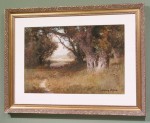n.d. Watercolor, 13-3/4″ x 20″. Framed in No. 308.2 “Michigan”—2-5/8″ in quartersawn white oak (Medieval Oak stain), with gilt ogee slip.
The “before” shot (at right) demonstrates the typical conventional contemporary framing approach for this type of piece. The silk mat and curly-cue gold frame seem intended for nothing but projecting an air of sophistication around the painting. In any case, the cool, atmospheric shadows so important to the quiet mood of the painting were not being well served by the white mat that was on the piece, contrasting so much with the deep shadowy tones of the painting that it actually interferes with the eye’s ability to adjust to the light the artist captures so effectively. Also, it couldn’t be less well-suited to the subtle tonal contrasts that are so crucial to the quiet mood of the painting. The incongruous framing not only fails to serve the painting itself, but creates a harsh divide between the painting and its surroundings. The gold frame may not look too bad in the photo at right, but is a production composition molding nailed together. (Composition, or compo, is a hard molded plaster that was increasingly used in the industrial period as a cheap, makeshift substitute for real carving.) One corner was already broken. The frame didn’t hold up to scrutiny — or to life!
What the painting needed instead was a dark frame, quiet and soft in profile, with just a halo of gold to highlight it on the wall while continuing and sustaining the spirit of the picture into the architectural realm.
The painting’s rustic spirit — completely ignored by the previous framing — and of course the oak trees Yard painted called unquestionably for an oak frame. (The protective aspect of the oak frame is another level of meaning for a depiction of oak trees sheltering a shepherd.) We stained the scoop a burnt umber (our Medieval Oak stain) matching the shadows — the frame being a shadow effect around the painting, to draw your eye to the lighter painting. Two fine reeds at the sight edge of the dark molding echo some of the fine details in the painting.
The piece is framed archivally by using a hidden, or “gasket,” mat under the liner to separate the picture from the glazing (in this case u.v.-filtering acrylic). The rabbet is lined with a metal tape to isolate the acids in the wood from the watercolor paper.
Framed for Montgomery Gallery of San Francisco. (See also this watercolor by Percy Grey, and this one…)

